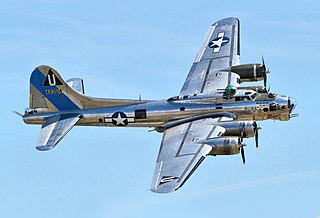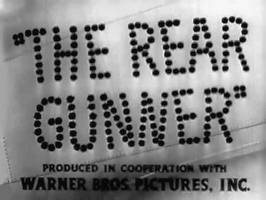
The Boeing B-17 Flying Fortress is an American four-engined heavy bomber aircraft developed in the 1930s for the United States Army Air Corps (USAAC). A fast and high-flying bomber of its era, the B-17 was used primarily in the European Theater of Operations and dropped more bombs than any other aircraft during World War II. It is the third-most produced bomber of all time, behind the American four-engined Consolidated B-24 Liberator and the German multirole, twin-engined Junkers Ju 88. It was also employed as a transport, antisubmarine aircraft, drone controller, and search-and-rescue aircraft.

The Martin B-10 was the first all-metal monoplane bomber to be regularly used by the United States Army Air Corps, having entered service in June 1934. It was also the first mass-produced bomber whose performance was superior to that of the Army's pursuit aircraft of the time.

The Glenn L. Martin Company, also known as The Martin Company from 1917 to 1961, was an American aircraft and aerospace manufacturing company founded by aviation pioneer Glenn L. Martin. The Martin Company produced many important aircraft for the defense of the US and allies, especially during World War II and the Cold War. During the 1950s and '60s, the Martin Company moved from the aircraft industry into the guided missile, space exploration, and space utilization industries.

The Consolidated B-24 Liberator is an American heavy bomber, designed by Consolidated Aircraft of San Diego, California. It was known within the company as the Model 32, and some initial production aircraft were laid down as export models designated as various LB-30s, in the Land Bomber design category.

The Convair B-36 "Peacemaker" is a strategic bomber built by Convair and operated by the United States Air Force (USAF) from 1949 to 1959. The B-36 is the largest mass-produced piston-engined aircraft ever built, although it was exceeded in span and weight by the one-off Hughes Hercules. It also has the longest wingspan of any combat aircraft. The B-36 is capable of intercontinental flight without refueling.

The Martin B-26 Marauder is an American twin-engined medium bomber that saw extensive service during World War II. The B-26 was built at two locations: Baltimore, Maryland, and Omaha, Nebraska, by the Glenn L. Martin Company.

The Douglas A-20 Havoc is an American light bomber, attack aircraft, night intruder, night fighter, and reconnaissance aircraft of World War II.

The Douglas B-23 Dragon is an American twin-engined bomber developed by the Douglas Aircraft Company as a successor to the B-18 Bolo.

The Martin 187 Baltimore was a twin-engined light attack bomber built by the Glenn L. Martin Company in the United States as the A-30. The model was originally ordered by the French in May 1940 as a follow-up to the earlier Martin Maryland, then in service in France. With the fall of France, the production series was diverted to Great Britain and after mid-1941, supplied by the U.S. as Lend Lease equipment.

Royal Air Force Tibenham or more simply RAF Tibenham is a former Royal Air Force station located 13.5 miles (21.7 km) southwest of Norwich and 5.8 miles (9.3 km) north of Diss, Norfolk, England.

The 17th Bombardment Group is an inactive United States Air Force unit. The group was last stationed at Hurlburt Field, Florida.

Target-Invisible is a 1945 documentary short film produced by the First Motion Picture Unit after World War II. The film depicts the uses of radar in aerial direction-finding and precision high-level bombing by the United States Army Air Forces during World War II.

Combat America is a 1945 documentary film produced in World War II, narrated by Clark Gable. At the time of the film's production in 1943, Gable was a 1st Lieutenant in the Eighth Air Force, part of the United States Army Air Forces. While he was stationed in England, Gable flew five combat missions from May 4–September 23, 1943, and during one of them, his boot was struck by an anti-aircraft shell, and he was nearly hit by other flak bursts. Gable's film crew included MGM cameraman Andrew J.McIntyre; 1st Lt. Howard Voss, a sound engineer; Master Sgt. Robert Boles, a cameraman; Master Sgt. Marlin Toti, another cameraman; and 1st Lt. John Mahlin, a scriptwriter."

The 22nd Operations Group is the operational flying component of the United States Air Force 22nd Air Refueling Wing. It is stationed at McConnell Air Force Base, Kansas, and is part of Air Mobility Command (AMC)'s Eighteenth Air Force.

Beyond the Line of Duty is a 1942 American short propaganda film, directed by Lewis Seiler. The documentary film reenacted the life and career of United States Army Air Corps Captain Hewitt T. "Shorty" Wheless.

Resisting Enemy Interrogation is a 1944 United States Army docudrama training film, directed by Robert B. Sinclair and written by Harold Medford and Owen Crump. The cast includes Arthur Kennedy, Mel Tormé, Lloyd Nolan, Craig Stevens and Peter Van Eyck. Resisting Enemy Interrogation was intended to train United States Army Air Forces (USAAF) crews to resist interrogation by the Germans.

During World War II, the United States Army Air Forces established a series of airfields in Australia for the collective defense of the country, as well as for conducting offensive operations against the Imperial Japanese Army and Navy. From these airports and airfields in Australia, the Fifth Air Force was able to regroup, re-equip and begin offensive operations against the Empire of Japan after the disasters in the Philippines and Dutch East Indies during 1942.

The Rear Gunner is a 1943 American short instructional film, directed by Ray Enright and produced by Warner Brothers. Previously, Warner Bros. had produced three short documentary films, Winning Your Wings (1942) starring Jimmy Stewart, Men Of The Sky (1942) and Beyond the Line of Duty (1942).

Men of the Sky is a 1942 American Technicolor short propaganda film, directed by B. Reeves Eason. The documentary film reenacted the training of a group of United States Army Air Forces (USAAF) pilots.

Elizabeth L. Gardner was an American pilot during World War II who served as a member of the Women Airforce Service Pilots (WASP). She was one of the first American female military pilots and the subject of a well-known photograph, sitting in the pilot's seat of a Martin B-26 Marauder.




















